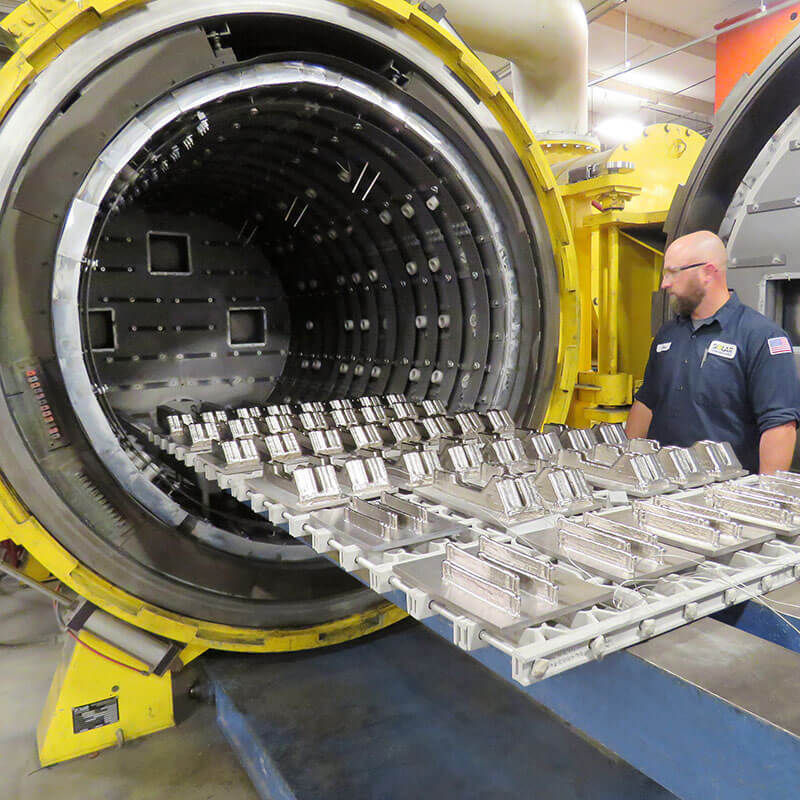Ask the Expert: Solar Atmospheres of Western PA’s President Discusses Vacuum Heat Treating Additive Manufactured Parts
1. Why are aerospace specifications for 3D printed components demanding that most thermal processing treatments be performed under a vacuum atmosphere?
Since additive manufacturing promotes low build-to-fly ratios and generates less feedstock waste, the shape that is ultimately printed will be very close to the final dimensions. Without machining or grinding operations to remove the traditionally contaminated surfaces which could be detrimental to mechanical properties, the use of the vacuum furnace is imperative.
A vacuum furnace used for heat treating AM parts must demonstrate extremely low leak rates (less than 5 microns per hour). It must also attain vacuum levels of 1×10-5 Torr range or lower, necessary to produce the clean and oxide-free results.
2. What are the different additive manufacturing processes used to print parts that you have seen?
Five years ago, we vacuum heat treated our first 3D printed parts manufactured by the Binder Jet Process (BJP). Initially this process proved problematic for our clean vacuum furnaces. If not fully de-lubed, the binder vaporized, attached to the cold wall of the furnace and coagulated into the pumps. This became a maintenance nightmare. Subsequently, we designed a better vacuum furnace with a cold trap to catch many of these detrimental elements.
Since then we have processed many Direct Metal Laser Sintered (DMLS) printed components. Most recently however, most of the printed work that we process is produced by the Electron Beam Additive Manufacturing (EBAM) process (see picture).
3. What type of materials and heat treatment processes are typical for an additive manufactured part?
The additive manufactured material we typically vacuum heat treat is titanium. The predominant thermal process is Vacuum Stress Relieving. Stresses inherent within the printed build are extreme. Layer by layer, molten deposition and solidification causes tremendous stresses. Thermally relieving these stresses in an inert atmosphere results in a more robust and stable part.
We have vacuum heat treated aerospace materials such as Inconel and Precipitation Hardening Stainless Steels. Vacuum solution annealing and vacuum aging are also thermal processes specified for AM parts.
4. Which industries are the early adopters and leading the charge of additive manufacturing technology?
An early adopter and now major leader of this transformational technology is the aerospace industry. Players in this industry are constantly striving to eliminate waste within their supply chains. In addition, they are always searching for better materials and newer designs to ultimately reduce the overall weight of aircraft. That weight savings has a direct correlation to improved fuel savings, which often determines the losses or profitability of airlines.
The medical device industry is beginning to ramp up within the AM arena. The intricacies of the human body can be mimicked by printing from an electronic file generated from an X-ray or a CAT scan. Therefore, this personalized technology often eliminates the need for large inventories of expensive implantable devices.
5. What are the major pitfalls and roadblocks of the 3D printing metallurgy?
A lack of industry-wide certifications and validations for this new metallurgy is the greatest challenge facing the additive manufacturing world. Contrary to traditional homogenous wrought metallurgy, a printed structure is a layer-by-layer melt shop. The microstructural variants derived by the heated and cooled affected zones of the build are truly understood by only a few primes. Their proprietary information, rightfully so, is extremely confidential. Therefore, in my opinion, standardized and published additive manufacturing specifications for each printing process is desperately needed in order for this new and exciting manufacturing method to flourish.
For more information: https://solaratm.com/markets/additive-manufacturing
And featured in Aerospace Manufacturing & Design Magazine: https://www.aerospacemanufacturinganddesign.com/article/5-questions-with-robert-hill


